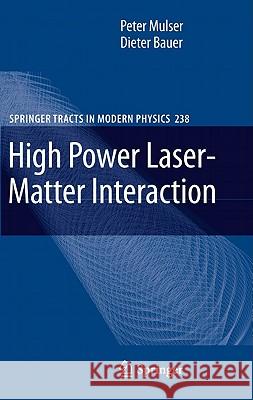High Power Laser-Matter Interaction » książka
High Power Laser-Matter Interaction
ISBN-13: 9783540506690 / Angielski / Twarda / 2010 / 416 str.
Inthepresentvolumethemainaspectsofhigh-powerlaser matterinteractionin 10 22 2 theintensityrange10 10 W/cm aredescribed. Weofferaguidetothistopic forscientistsandstudentswhohavejustdiscoveredthe eldasanewandattractive areaofresearch, andforscientistswhohaveworkedinanother eldandwantto joinnowthesubjectoflaserplasmas. Beingawareofthewidedifferencesinthe degreeofmathematicalpreparationtheindividualcandidatehasacquiredwetried topresentthesubjectinanalmostself-containedmanner. Tobemorespeci c, a bachelordegreeinphysicsenablesthereaderinanycasetofollowwithoutdi- culty. Generally uidorgasdynamicsanditsrelativisticversionisnotapartof thiseducation;itisdevelopedinthecontextwhereitisneeded. Basicknowledgein theoreticalmechanics, electrodynamicsandquantumphysicsaretheonlyprereq- sitesweexpectfromthereader. Throughoutthebookthemainemphasisisonthe variousbasicphenomenaandtheirunderlyingphysics. Notmoremathematicsthan necessaryisintroduced. Thepreferenceisgiventoideas. Agoodmodelisthebest guidetotheadequatemathematics. Thereexistalreadysomebutnotsomany, however, goodvolumesandsome monographsonhigh-powerlaserinteractionwithmatter. Afterresearchinthis eld hasgrownoverhalfacenturyandhasrami edintomanybranchesoffundamental studiesandapplicationsproducingcontinuouslynewresults, thereisnoindication ofsaturationorlossofattraction, ratherhasexcitementincreasedwiththeyears: Therearenolimits;horizonsonly (G. A. Mourou). Wetakethisasamotivation foranewattemptofpresentingourintroductiontotheachievementsfromthebeg- ninguptopresent. Anadditionalaimwastoofferamoreuni edormoredetailed viewwherethisispossiblenow. Furthermore, thereadermay ndconsiderations not encountered in existing volumes on the eld, e. g., on ideal uid dynamics, dimensionalanalysis, questionsofclassicaloptics, instabilitiesandlightpressure. Inviewoftherapidlygrowing eldofatoms, moleculesandclustersexposedto superstronglaser eldsweconsidereditascompulsorytodedicateanentirechapter tolaser atominteractionandtothevariousmoderntheoreticalapproachesrelated toit. Finally, aconsistentmodelofcollisionlessabsorptionisgiven. Dependingonpersonalpreferencesthereadermaymissperhapsasectionon inertialfusion, onhighharmonicgenerationandonradiationfromtheplasma, or ontraditionalatomicandionicspectroscopy. Inviewofthespecializedliterature vii viii Preface alreadyavailableonthesubjectswethinktheself-imposedrestrictionisjusti ed. Ourreferencingpracticewasguidedbyindicatingmaterialforsupplementaryst- iesandestablishingacontinuitythroughthedecadesofresearchinthe eldrather thanbytheaimofcompleteness. Thelatternowadaysiseasilyachievablewiththe aidoftheInternet. Wehavetestedthetextwithrespecttocomprehensionandreadability. Our rst thanksgotoProf. EdithBoriefromtheForschungszentrumKarlsruhe. Shepro- readgreatpartsofthetextverycarefullyandgavevaluablecomments. Insecond placewewouldliketothankMrs. ChristineEidmannfromTheoreticalQuantum A Electronics (TQE), TU Darmstadt, for typing in LTX half of the book. We are E furtherindebtedtoProf. RudolfBockfromGSI, Darmstadt, forhelpfuldiscussions andprecioushints. Furtherthanksforhelpfuldiscussions, criticalcomments, che- ingformulasgotoDr. HerbertSchnabl, Prof. WernerScheid, Dr. RalfSchneider, Dipl. -Phys. TatjanaMuth, Dr. SteffenHain, andDr. FrancescoCeccherini. Wewant toacknowledgeexplicitlythecontinuouseffortandsupportinpreparingthe nal manuscript by Dr. Su-Ming Weng from the Insitute of Physics, CAS, China, at presentfellowoftheHumboldtFoundationatTQE. Forhisprofessionalinputto thesectiononBrillouinscatteringspecialthanksgotoDr. StefanHullerfromEcole PolytechniqueinPalaiseau. Darmstadt, Germany PeterMulser Rostock, Germany DieterBauer Contents 1 Introductory Remarks and Overview . . . . . . . . . . . . . . . . . . . . . . . . . . . . . 1 2 The Laser Plasma: Basic Phenomena and Laws. . . . . . . . . . . . . . . . . . . . 5 2. 1 Laser ParticleInteractionandPlasmaFormation. . . . . . . . . . . . . . . . . 6 2. 1. 1 High-PowerLaserFields. . . . . . . . . . . . . . . . . . . . . . . . . . . . 6 2. 1. 2 SingleFreeElectronintheLaserField(Nonrelativistic). . 9 2. 1. 3 CollisionalIonization, PlasmaHeating, andQuasineutrality 13 2. 2 FluidDescriptionofaPlasma. . . . . . . . . . . . . . . . . . . . . . . . . . . . . . . . . 24 2. 2. 1 Two-FluidandOne-FluidModels. . . . . . . . . . . . . . . . . . . . . 24 2. 2. 2 LinearizedMotions. . . . . . . . . . . . . . . . . . . . . . . . . . . . . . . . . 37 2. 2. 3 SimilaritySolutions. . . . . . . . . . . . . . . . . . . . . . . . . . . . . . . . 44 2. 3 LaserPlasmaDynamics. . . . . . . . . . . . . . . . . . . . . . . . . . . . . . . . . . . . . . 58 2. 3. 1 PlasmaProductionwithIntenseShortPulses . . . . . . . . . . . 60 2. 3. 2 HeatingwithLongPulsesofConstantIntensity. . . . . . . . . 63 2. 3. 3 SimilarityConsiderations. . . . . . . . . . . . . . . . . . . . . . . . . . . . 69 2. 4 SteadyStateAblation. . . . . . . . . . . . . . . . . . . . . . . . . . . . . . . . . . . . . . . . 74 2. 4. 1 TheCriticalMachNumberinaStationaryPlanarFlow. . . 75 2. 4. 2 AblativeLaserIntensity. . . . . . . . . . . . . . . . . . . . . . . . . . . . . 78 2. 4. 3 AblationPressureintheAbsenceofPro leSteepening. . . 82 References. . . . . . . . . . . . . . . . . . . . . . . . . . . . . . . . . . . . . . . . . . . . . . . . . . . . . . 85 3 Laser Light Propagation and Collisional Absorption . . . . . . . . . . .











